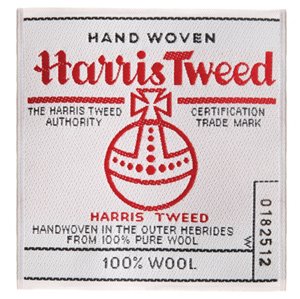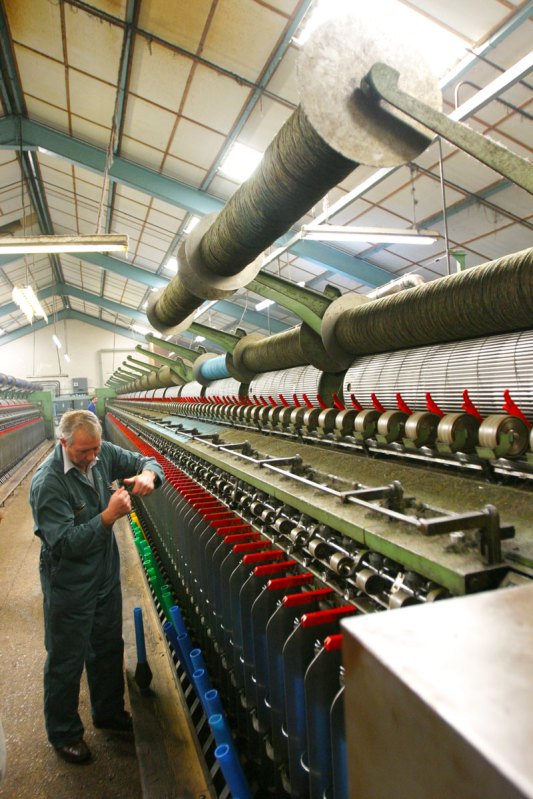Wool clothing is making a comeback! I’m happy to say that Harris Tweed is becoming popular again. Probably most people have heard of Harris Tweed but I can bet that most people don’t know much about it or where it comes from. At least I didn’t before I found myself in the middle of it…

In 2004, I was fortunate enough to visit a working Harris Tweed mill in the very remote coastal village of Shawbost (Scottish Gaelic: Siabost) on the Isle of Lewis in Scotland. The proprietor of the B&B where we were staying was a former weaver. He gave us the inside scoop on where the mill was and how to go about getting inside to visit. We drove to the mill, a very plain white building like most of the houses and buildings on the island where everything is painted white. Right away we were greeted and given a personal tour by one of the mill workers. The Scotsman, a very friendly chap, happily walked us through the entire mill starting with the dying process of the creamy white wool to the spinning process where the wool is spun onto colorful spools. It’s from these spools that the weavers hand weave the wool in their homes into beautiful Harris Tweed. During our visit to the mill, some of the wool being produced was a beautiful mix of brown and olive green. Our tour guide told us it was being made for Nike for some of their limited edition shoes. At the end of the tour, we saw stacks of the finished product brought in from the homes of the weavers in every color imaginable ready for shipment or waiting for future orders.
So what is Harris Tweed? Real Harris Tweed is a cloth made from local virgin wool hand-woven by the islanders at their homes in Outer Hebrides of Scotland. For centuries, the remote island communities on Harris, Lewis, Uist, and Barra maintained a sustainable, local industry of tweed weavers who manufactured the fabric mostly for personal use and sold on a very small market. The weavers had developed their methods over centuries, and while the rest of Scotland experienced the Industrial Revolution in the 1790s, the Outer Hebrides islanders remained committed to their traditional weaving heritage.

During the Highland Potato Famine in 1846, The Countess of Dunmore had the family tartan copied in Harris Tweed by the local weavers and made into suits for the estate gamekeepers. It was a success and she recognized the sales potential of the fabric and a way to help the local industry. As a result of the marketing efforts and improvement in the process of production of Lady Dunmore, increased sales of the tweed were achieved and trade was established with cloth merchants in large towns in the United Kingdom. Between 1903 and 1906 the tweed making industry in Lewis increased rapidly when new spinning machinery and a second mill was opened in the town of Stornoway just down the road from Shawbost. At the turn of the century the small primitive loom was replaced by the improved “fly-shuttle” loom which was heavier and made weaving now an occupation for men rather than women.

In 1906, the Harris Tweed wool industry wanted to trademark their wool to end the increasing practice of some people offering their mill-spun tweed as genuine Harris Tweed. The certification mark was granted in 1909, registered in 1910 and stamping of the tweed trademark consisting of the Orb and Maltese Cross with the words Harris Tweed underneath began in 1911.

Over the years the Harris Tweed jacket was popular in fashion. It was said that anyone with any sort of substance of style should have a least one Harris Tweed jacket in their wardrobe.
In the late 1980s the Harris Tweed industry declined along with the textile industries in the rest of Europe. I haven’t researched the reasons why but my theory is that the synthetic fabrics starting to become popular in the 70’s had something to do with it. Fashions change over the years is probably another reason. Back in the early ’80s, synthetic fabric for outdoor clothes made in Asia or other 3rd world countries was starting to take over and become the latest thing. I remember getting my first Patagonia synchilla jacket back in 1984 along with the latest polypropylene and fleece garments that were the newest rage.
After the tour of the Shawbost Harris Tweed mill in 2004, I really wanted to help support the Harris Tweed industry and purchase a Harris Tweed garment. I shopped around to find fashionable women’s clothing items to purchase but couldn’t find much available. I remember back then how it would be my dream to move to the Outer Hebrides of Scotland and figure out a way to revitalize the Harris Tweed industry or hoping someone would. Since that visit in 2004 ‘Harris Tweed Hebrides’ founded in 2007 took over the Shawbost mill. 95% of the Harris Tweed is now produced there. More weavers are being re-hired and re-trained to make a new lighter weight and softer tweed. The company now exports to more than 40 countries and supplies designers like Calvin Klein and Ralph Lauren. Smaller companies offering Harris Tweed products are becoming more popular. A simple Internet search will find all sorts of on-line stores. Roobedo, Catherine Aitken and Harris Tweed and Knitwear are Scottish based companies that have great purses and other accessories that I especially like.
To

Wool seemed like a thing of the past to some people but not anymore. I’m seeing more companies like Smart Wool, Ibex or Icebreaker making fashionable quality wool clothing for all ages. People are switching from the synthetic stuff back to wool and loving it.
If you plan to buy any Harris Tweed in the future, which I hope you do, look for the Orb and the Maltese Cross label to ensure you are purchasing the real thing. By doing this, your are supporting the weavers and keeping this tradition and craft of the people of Outer Hebrides of Scotland alive for more years to come.

